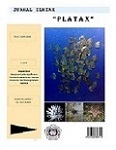Allometry Analysis and Physiological Index of Sea Urchin Heliocidaris crassispina (A. Agassiz, 1864) (Camarodonta, Echinometridae) on the Reef Flat in Tongkeina and Malalayang Dua, Manado, Sulawesi
DOI:
https://doi.org/10.35800/jip.4.2.2016.13774Abstract
The purpose of this study was to analysis the structure of the size, morphometry (test diameter-high relationship, test diameter-weight relationship) as well as gonad indices, intestine indices, and Aristotle lantern indices of Heliocidaris crassispina in two different habitats, Malalayang Dua and Tongkeina. At each habitat, free sampling on the reef flat have be done one time for approximately two hours at the lowest tide. The abundance of individuals H. crassispina in Malalayang Dua was much lower than in Tongkeina. The means diameter of sea urchins test were not significantly different between habitats. The comparison of regression lines of both diameter-high and diameter-weight relationships were not differ significantly between habitats. Its morphometry reveal an isometric relationship of high-diameter (slope = 1) in both habitats, while the relationship of weight-diameter reveals a negative allometric growth (slope < 3) in Tongkeina but isometric growth in Malalayang Dua. The gonad index in Malalayang Dua was higher than in Tongkeina. The intestine index in Tongkeina was higher than in Malalayang Dua. The lantera index in Tongkeina was higher than in Malalayang Dua. The difference in abundance of sea urchins and the acquisition of the energetic value of food presumably serve as the factors affecting the differences of these indices and its weight growth pattern.
________________________________________________________________
Keywords: Heliocidaris crassispina, allometry analysis, physiological index
ABSTRAK
Tujuan dari penelitian ini adalah untuk menganalisis struktur ukuran, morfometri (hubungan diameter-tinggi cangkang, hubungan diameter-berat) serta indeks gonad, indeks usus, dan indeks lentera Aristoteles dari Heliocidaris crassispina di dua habitat yang berbeda, Malalayang Dua dan Tongkeina. Pada setiap habitat, sampling bebas di rataan terumbu telah dilakukan satu kali selama kurang lebih dua jam pada saat pasang terrendah. Kelimpahan individu H. crassispina di Malalayang Dua jauh lebih rendah daripada di Tongkeina. Diameter rata-rata cangkang bulu babi tidak berbeda nyata antara habitat. Perbandingan garis regresi hubungan diameter-tinggi dan diameter-berat tidak berbeda secara signifikan antara habitat. Analisis morfometri menunjukkan hubungan isometrik tinggi-diameter (slope = 1) di kedua habitat, sedangkan hubungan berat-diameter menunjukkan pertumbuhan alometrik negatif (kemiringan <3) di Tongkeina tetapi di Malalayang Dua menunjukkan pertumbuhan isometrik. Indeks gonad di Malalayang Dua lebih tinggi daripada di Tongkeina. Indeks usus di Tongkeina lebih tinggi daripada di Malalayang Dua. Indeks lantera di Tongkeina lebih tinggi daripada di Malalayang Dua. Perbedaan kelimpahan bulu babi dan perolehan nilai energik makanan diduga berperan sebagai faktor yang mempengaruhi perbedaan indeks ini dan pola pertumbuhan beratnya.
________________________________________________________________
Kata kunci: Heliocidaris crassispina, analisis allometri, indeks fisiologis
____________________
1Bagian dari Skripsi
2Mahasiswa Program Studi Manajemen Sumberdaya Perairan FPIK-UNSRAT
3Staf Pengajar Fakultas Perikanan dan Ilmu Kelautan UNSRAT
Downloads
How to Cite
Issue
Section
License
COPYRIGHT
Authors who publish with this journal agree to the following terms:
Authors hold their copyright and grant this journal the privilege of first publication, with the work simultaneously licensed under a Creative Commons Attribution License that permits others to impart the work with an acknowledgment of the work's origin and initial publication by this journal.
Authors can enter into separate or additional contractual arrangements for the non-exclusive distribution of the journal's published version of the work (for example, post it to an institutional repository or publish it in a book), with an acknowledgment of its underlying publication in this journal.
Authors are permitted and encouraged to post their work online (for example, in institutional repositories or on their website) as it can lead to productive exchanges, as well as earlier and greater citation of the published work (See The Effect of Open Access).




















